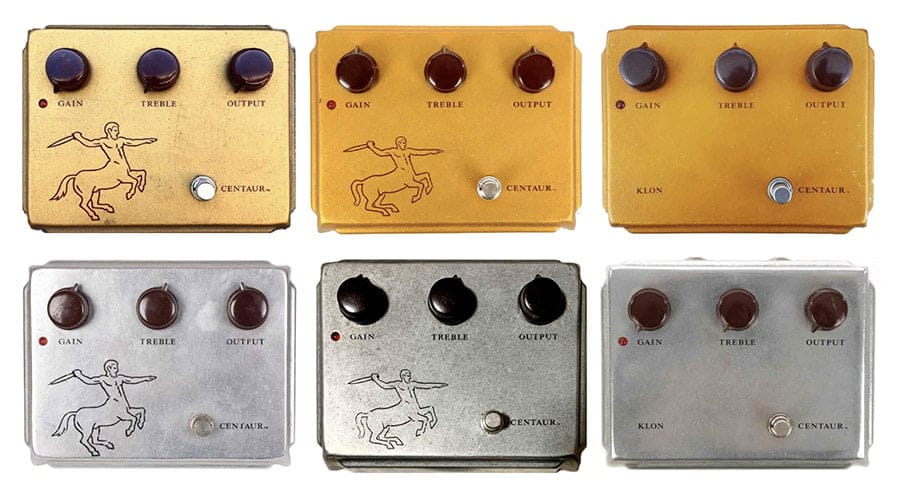
The early 1990s were the time of the diva; Whitney, Mariah, Celine, Madonna, Paula, and Janet all had chart-toppers with luxurious tones, silky sounds, and lavish qualities that are iconic. While Whitney Houston was making musical fireworks with her “Star Spangled Banner” at Super Bowl XXV, another iconic diva with luxurious tones and silky sounds was being created in a small workshop in New England.
Bill Finnegan is a fellow guitarist who encountered the age-old problem that plagues us even today; the overzealous soundman. At some of the smaller clubs, he could not run his amp’s volume high enough to get those warm, delicious edge of breakup tones he desired. He searched for a magic elixir to give him the tone he desired at low volumes, and a few pedals came through his hands, but they all fell short.
The Birth of a Legend
Bill did what any self-respecting guitarist does: He turned his amp down to make the sound man happy, NOT! He decided, with the help of a couple of MIT buddies, to develop a guitar pedal with an audio circuit that would help push the amp to the point of breakup but still allow the amp to be played at low volumes. After four and a half years of designing, building and testing, the Klon Centaur debuted in 1994.
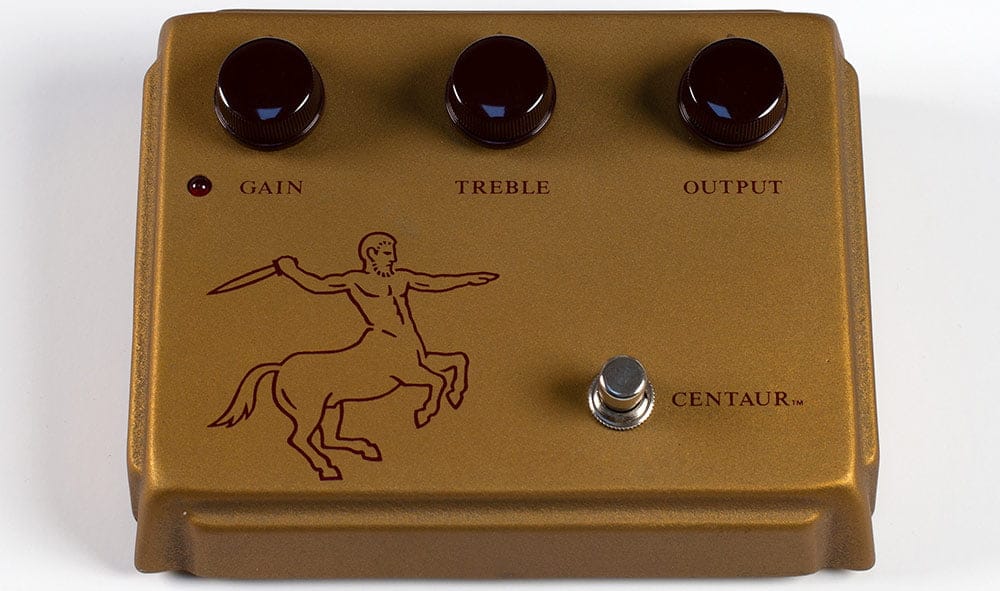
The original Klon Centaur today is regarded as the Mount Olympus of overdrive pedals, which is appropriate considering the mythological half-man, half-horse that emblazons the face of the pedal. The original price of the Klon when it was released in 1994 was a mere $219. That was a great investment if you happened to buy one considering you can now find advertisements for original Klons selling for $5K or more. Josh Scott, the owner of JHS Pedals, has offered his all-original serial #2 (actually, it was the first one ever built, but that is another story) to the public for a cool half a million dollars, hand-delivered anywhere in the world.
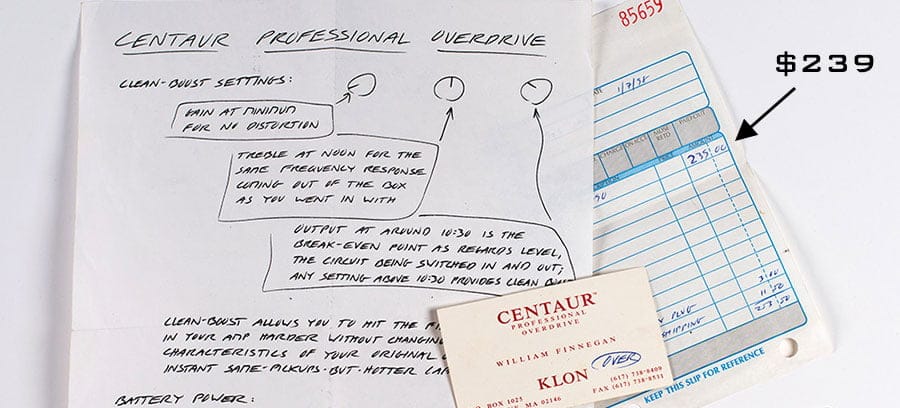
The Klon has gone through a few cosmetic changes as it evolved. The cast aluminum housing was painted Bronze, Yellow Gold, Orangey Gold, Silver, and even what appears to me to be a clear coat over the raw aluminum finish. No matter the exterior color, the tone still remains the same.
Klons fall into two categories: the “Golden Horsie” (Bronze, Yellow Gold or Orangish Gold finished enclosures) or the “Silver Horsie,” with the raw aluminum or silver-looking enclosure. From what most have researched, there is a pretty even number of gold and silver Klons in existence. Even the mythical Centaur has changed a little through the years but the magical tones remain whether there is a “Horsie” on the front or not.
- 1994 Centaur launched with “Golden Horsie Long Tail”
- 1995 Silver “Silver Horsie Long Tail” released
- 1998 Centaur graphic redesigned with less detail and a shorter tail – “Golden or Silver Horsie Short Tail”
- 2003 “No Horsie” model with the graphic deleted, the word “KLON” printed in the left bottom corner.
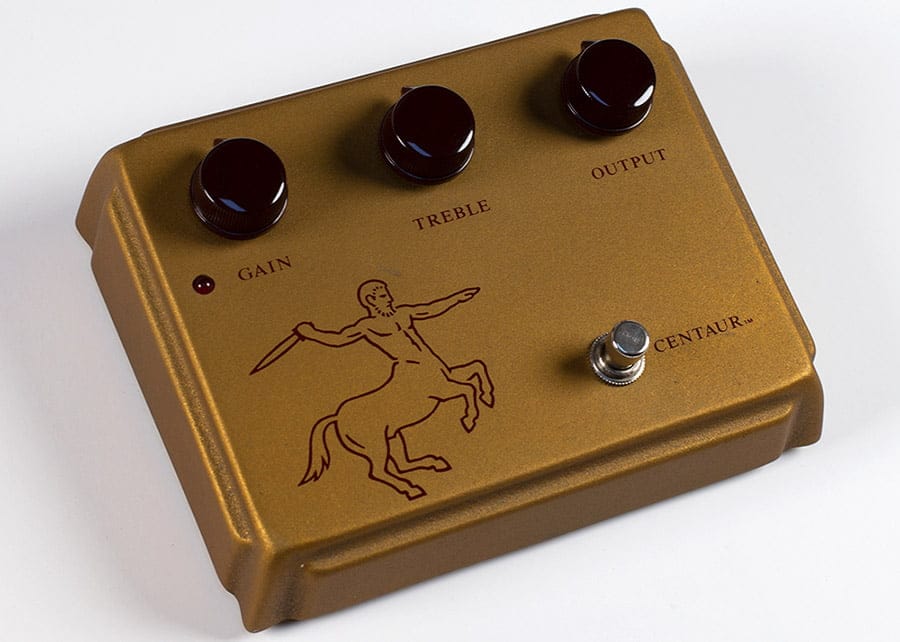
Secrets of the Klon
The secret sauce of the Klon is its ability to send an audio signal to a tube amp and replicate that sweet overdriven sound. That tone happens when the preamp circuit and the transformer of the amp are overdriving the pre-amp tubes at high volumes. The Klon creates this overdriven tone with its unique circuitry allowing the amp to be played at lower volumes. It takes some knowledge of electrical circuitry to really appreciate what is happening with a Klon, but that doesn’t mean you need to brush off that Advanced Electrical Circuitry book to grasp what it does and how it does it.
An electric guitar, for all intents and purposes, is a very low-electrical output device. The string’s vibrations are sensed by the guitar’s pickups, which convert that energy into a very low electrical signal. That signal then passes through the guitar’s volume and tone controls and is then ferried by a guitar cable to your amplifier. The amplifier takes that signal and amplifies it, allowing us to hear the tones created at increased volume through the amplifier’s speaker.
Go With the Flow
So how does the Klon do what it does? Let’s keep it simple; I like to think of electrical circuity like water flowing in a stream. Bill Finnegan chose the Klon’s specific germanium diodes, which created a unique circumstance for the signal flow. Most pedal circuits utilize silicone diodes which are cheaper but also have a greater VBE (voltage between base and emitter) rate than germanium diodes. Think of the diodes like a dam in our stream illustration. The silicone diode has a VBE of about 0.7 volts, whereas the germanium diode’s VBE is 0.3 volts. The lower VBE of the germanium diodes is what I believe allows the Klon to keep that bassy low end and not compress the signal as much as silicone diodes do.
Saraswats group has shown that germanium transistors (diodes) are significantly better than silicone transistors in the nanometer range regarding low voltage signals, like those voltages from an electric guitar. The diodes are not the only special sauce inside a Klon but they are a key component and can’t be overlooked.
Also, keep in mind that the Klon does not operate at just 9 volts; it runs up to 27 volts which increases the clean headroom available for the signal. Bill designed a power section that uses a MAX1044 voltage converter to increase the voltage in the last stages of the circuit, increasing the clean headroom available before clipping begins.
You can see the schematic for the power circuit below. Notice the 27V rating at R29 and R30 resistors.

Those are just a couple of the surprising design elements that make up the legendary Klon circuit. The schematic has always been hidden behind a layer of thick black goop applied to the front and back of the circuit board to keep people from altering the circuit or stealing its secrets.
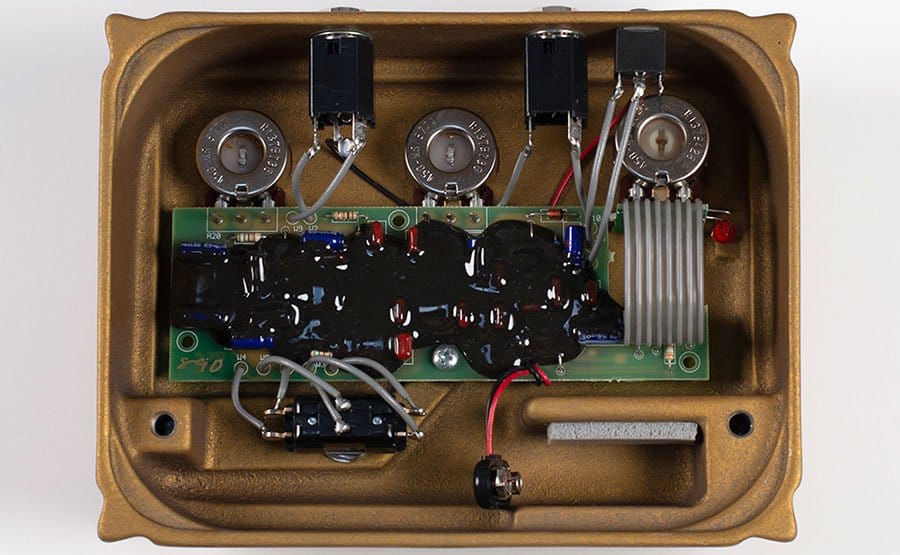
The Wrath of Klon
The mystery around the pedal is even more complicated than the actual electrical components inside the pedal. Once the Klon started making its rounds among guitar circles, the demand for the handmade pedal skyrocketed. To order a Klon, one first had to contact Bill and discuss their gear and their expectations of the pedal.
Bill wanted everyone to understand how to use the Klon and how it would interact with the user’s gear. His lead time for a new Klon typically ran 12-14 weeks as he built them in his living room on a folding card table. The long order process saw the used Klon market skyrocket by those who wanted one immediately. The overwhelming demand of a one-man shop eventually took its toll.
Bill quit taking orders in 2008, overwhelmed by the demand and the affronts among the guitar community regarding his creation which only created even more demand. Although some special units were made after 2008, the original Klon Centaurs are extremely rare, and they are among the most expensive guitar pedals on the market today.
The Hype
Eventually, his creation ended up on the pedal boards of many of our guitar heroes which only fanned the flames of desire among the guitar community. Jeff Beck, Mark Tremonti, John Mayer, Andy Summers, Peter Frampton, Jason Isbell, James Hetfield, Joe Perry, Britt Daniel, David Grissom, Adam Hann, and Joe Bonamassa to name just a few who utilize the Klon. Some use it as a clean boost, others as a transparent overdrive, but no matter how they are using it, the Klon is a fixture on a lot of guitarists’ boards and has achieved a mythical reputation in the guitar community.
Take a Listen
You can hear the Klon in action with John Mayer in the clip below. Gain is set around 10 o’clock, treble at 2 o’clock, and the output, well, you can’t quite see that, so you will have to get your own Klon and play around with it to find out.
You can hear the difference the Klon makes on a Vox AC30 tube amp in the clip below.
A Silver Horsie in action with multiple settings utilized in the video below.
Klon or Clone
Unless you have a few thousand dollars laying around, the Klon is probably out of reach financially. But, don’t fret (pardon the pun); there are some usable options that will save you a few bucks and still give you that legendary tone.
The NOS Klon
We said earlier that Bill Finnegan quit making the Klon back in 2008, right? Well, yes and no. Bill recently made a post on Instagram that he has made a Klon pedal to allow a very close friend of his to list on eBay to help them get through some financial difficulties.
There is also an eBay seller called “klondirectsales” which apparently is Bill’s page where he builds a few pedals on a small scale and sells them there. His last Klon listing ended on Christmas Eve of 2018 (Merry Christmas for someone!) and sold for a little over two grand.
So, make sure to update your eBay profile and Keep your eyes peeled; who knows when a NOS Klon might pop up on the Bay.
The Son of Klon
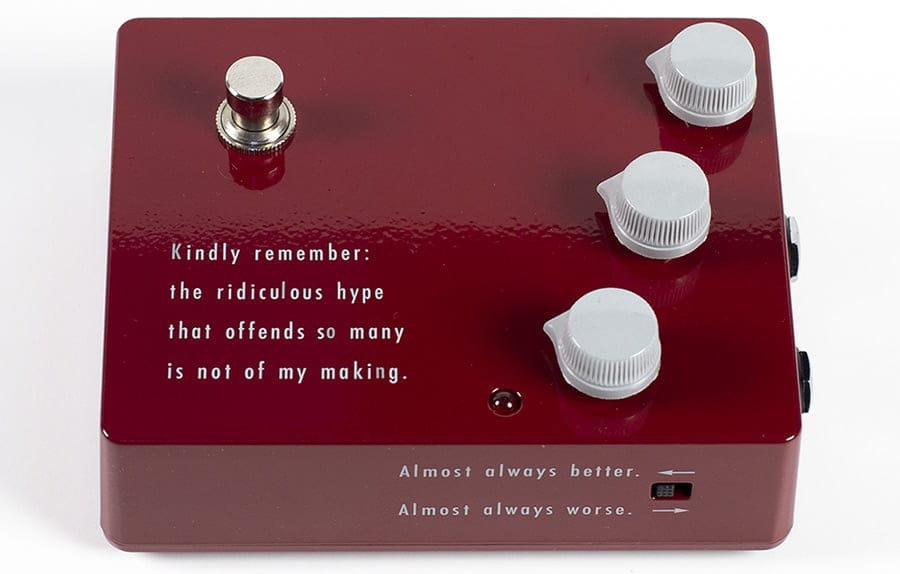
If you are a Klon purist but don’t have the coin to shell out for an authentic gold or silver Horsie, then you might want to look at the Klon KTR. You can pick up one of these re-issued red Klon models for around $700 used currently. They originally were introduced in 2012 and sold for a mere $269.00. Production ceased in 2019, but there is a rumor there might be a version 2 on the horizon albeit with some different diodes, since the original diodes are depleted (other than the ones Bill has held onto).
Some retailers still have the KTR listed on their site as an out-of-stock item, so the rumor of a new run might, in fact, be true. The used market is your best bet currently if you want one of the first versions. You might not want to wait to grab one of these re-issues now as the used prices continue to climb.
Fawn Over This Clone
The Wampler Tumnus pedal is a great Klon option that should be “fawned” over. For less than $150 you can dial in that classic tone and still have some room on the board since it is a mini pedal. Toss in a few more bucks and you can get the even more versatile Tumnus Deluxe, which also has a three-band EQ.
A “Huge” Bargain
The Way Huge Conspiracy Theory pedal comes really close to nailing that huge Klon tone. For less than $150 it is an affordable addition to any guitarist’s board to dial in those transparent overdriven tones to make your amp sound, well, “huger.”
A Horsie for the Cost of a Pony
For those on a budget, the Bad Horse from Tone City can be had for a song. At $69, this inexpensive mini pedal will allow you to add another pedal or two to your board without breaking the bank. Keep in mind you get what you pay for, but if you want to dip your toe into the Klon world and not break the bank, this is a great option.
A Celebration of Creation
Whether you are a Klon purist, a recent clone adopter, or just in the market for a boost/overdrive pedal, there is one thing that cannot be argued regarding the Klon. Bill Finnegan’s mythical creation will go down as one of the most hyped guitar pedals of all time.
It has graced the board of so many guitarists, and whether you are a fan or not, it cannot be argued that the hype surrounding this pedal is astounding. From humble beginnings to mythical fame, the Klon has definitely carved a place for itself in the Parthenon of guitar pedals.
Also, “kindly remember: the ridiculous hype that offends so many is not of my making…” Bill Finnegan.
Share your thoughts in our forum! 💬
👉 Introduce yourself and show off your guitar pedals and other gear.
Share this post with your friends using these one-click sharing options:
👉 Click here to share on Facebook.
👉 Click here to share on X.
👉 Click here to share on LinkedIn.
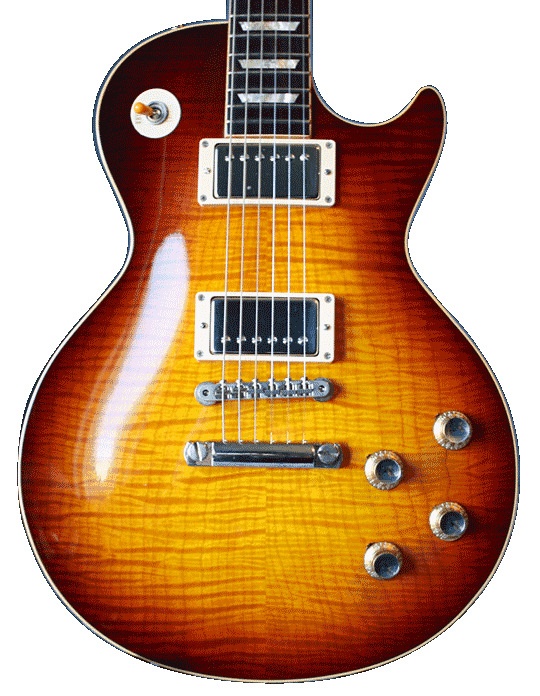
Get the latest reviews, guides and videos in your inbox.